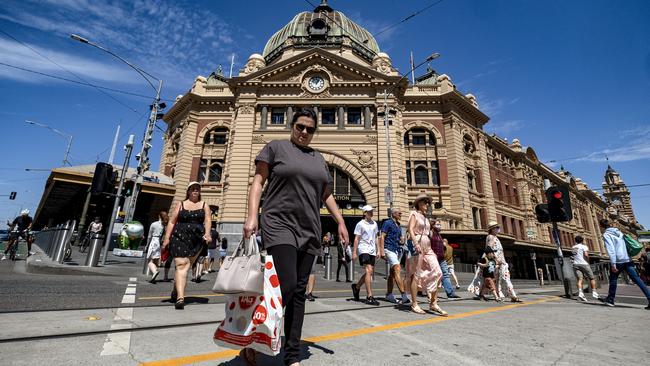Coronavirus curtain traps unskilled workers
The pandemic has created a gigantic job slide based on Australians’ skills — and a new social fault line has emerged.

The coming of the coronavirus has changed the Australian workforce and not just by prompting adaptation to new technology like Zoom calls and triggering a work-from-home movement, but also by rigidly dividing the nation according to skill sets.
For many years, the workforce has been polarising with strongest job growth at both the skilled and the unskilled ends of the skills spectrum. But come the time of COVID and it seems that job security — let alone job opportunity — is now largely the preserve of the skilled workforce.
It’s low-skilled and unskilled workers who have borne the brunt of job losses caused by lockdown and border closure. Indeed this skills-based social division of the Australian community is sure to be exacerbated with the removal of JobKeeper at the end of March.
The Australian Bureau of Statistics classifies every job according to one of five skill levels with Skill Level 1 being the most skilled. A Skill Level 1 job requires a bachelor’s degree or higher, or the equivalent of at least five years’ training. The census boffins place surgeons and engineers together with television presenters in this most skilled category.
In the 12 months to February 2020 (the year before the coming of the coronavirus) the number of Skill Level 1 jobs jumped by 185,000 or by 5 per cent to 4.292 million (or 33 per cent of the workforce).
At the other end of the spectrum, Skill Level 5 jobs requiring little or no previous work experience (like general sales assistant, kitchen hand) increased by 53,000 or by 3 per cent; this group accounts for 16 per cent of the workforce.
However over the same time frame the number of jobs available to Middle Australia (Skill Level 3 jobs such as mechanic, secretary) fell by 62,000 or by 3 per cent.
The Australian workforce was already going through a hollowing-out process in the years leading up to the pandemic. And the reason is relatively straightforward: the digitisation of the economy means there is an increasing requirement for more skilled workers. This is partly why Australia has had a skilled migration program.
The pandemic has had the effect of accelerating the digital transformation of businesses and the workplace, and this has hyped demand for highly skilled workers.
Early in the pandemic, job losses were greatest in the Skill Level 4 and 5 strata of the workforce down 290,000 and 325,000 jobs respectively over the three months to May. There was recovery in these job categories over the following six months to November, up 163,000 jobs in Skill Level 4 and 228,000 for Skill Level 5.
But the May-to-November gains in low-skilled jobs did not fully offset the February-to-May losses. As of November the least skilled workforce (Skill Level 5) was still down 5 per cent on the pre-COVID February high.
It’s a very different story for our most skilled workers. In the February-to-May time frame Skill Level 1 jobs contracted by 1 per cent (or by 35,000 jobs). But this loss was offset by gains of 140,000 jobs in the next three months, and by another 60,000 jobs in the following three months.
Indeed, across nine months to November 2020 — encompassing the most severe lockdowns and border closures — Skill Level 1 jobs increased in net terms by 166,000 or by 4 per cent, according to ABS labour force reports.
On a pro-rata basis Skill Level 1 workers enjoyed more net new job growth over nine months of the COVID year than during all 12 months of the pre-COVID year.
Indeed Skill Level 1 jobs that surged most between February and November include accountants (up 28,000 or 14 per cent), solicitors (up 21,000 or 22 per cent), software and applications programmers (up 20,000 or 14 per cent), and supply, distribution and procurement managers (up 12,000 or 26 per cent).
The pandemic triggered demand for skills in finance (accountants), in risk management (solicitors), in computer programming and in distribution and logistics.
However the story for the balance of the workforce has been quite different.
Between February and November 2020 the number of workers in jobs defined by the ABS as Skill Levels 2, 3, 4 and 5 (all but the most skilled work) decreased by 2 per cent, 3 per cent, 4 per cent and 5 per cent, respectively.
The pandemic has created a gigantic job slide, based on skill sets: the less skilled a worker, the greater the likelihood of that worker being tipped out of a job.
And of those low-skilled workers who did manage to remain employed throughout last year, very few would have had the opportunity to work from home.
The point being that in the Australian experience with the pandemic (to November at least) very much depended on the skills of the worker. Skilled workers were exposed to more job opportunity during the pandemic than over the previous year. Plus, many (but not all) workers from this cohort also had the option of working from home.
But there is another angle to COVID’s bifurcation of the Australian workforce.
At an aggregate level one-third of workers operate from within the “safety” of a Skill Level 1 job but in the central and/or well-to-do suburbs of our major cities, this cohort comprises more than half the resident workforce.
In Sydney, for example, based on 2016 census results, Skill Level 1 workers dominate the resident workforce across the eastern suburbs, the north shore and throughout the inner west. And the reason is that Skill Level 1 workers tend to work in the businesses and in the institutions of the CBD and the inner city.
Skill Level 1 workers in Melbourne comprise more than half the resident workforce in the central, inner eastern and bayside suburbs. Brisbane’s most skilled workers generally cluster in a bubble extending west of the CBD. Perth’s most skilled workers also generally live west of the CBD. While in Adelaide most skilled workers congregate in North Adelaide, in technology and/or military precincts in the city’s north while others cluster in the Adelaide Hills.
The picture that emerges is of an Australia that has been divided by its experience with the pandemic. Some, perhaps even many, workers have actually prospered during these most turbulent of times. But many others haven’t been quite so fortunate.
The imminent removal of JobKeeper support could well tip many low-skilled and unskilled workers into unemployment, exacerbating social division based not so much on class or wealth but on new measures, namely access to skills and even on the basis of geography.
The centres of Sydney and Melbourne in particular present as “islands of opportunity” for the highly skilled for they sit amid a broader metropolitan sea of uncertainty for the unskilled and the low skilled.
A resilient nation such as Australia can cope to some degree with periods of disadvantage; we’re a patient people who generally have faith that things will right themselves in due course.
But if social division triggered or exacerbated by the pandemic were to remain entrenched or heightened during the recovery, and seemingly without the prospect of correction, then this could well lead to a diminution in social cohesion and a breakdown in the underlying social contract that makes our nation work.
Australia’s ennobling idea of opportunity for all, expressed as a fair go for all, must survive the test of skills defining a worker’s prospects and place in a post-COVID world.
The point being that we have weathered the COVID storm, we have survived the bullying of trading partners (thus far), even our economy — generally — is considered to be in reasonable shape.
But in rebuilding a better post-COVID Australia we need to ensure that there is opportunity for all, including for the low skilled and the unskilled, for the residents of the suburbs and for the residents of the regions.
And we need to create a society whereby skills — the currency of the 21st century labour market — are cultivated and easily accessed by any Australian with the interest and the determination to help make this nation a better place.
Bernard Salt is executive director of The Demographics Group; research by data scientist Hari Hara Priya Kannan


To join the conversation, please log in. Don't have an account? Register
Join the conversation, you are commenting as Logout